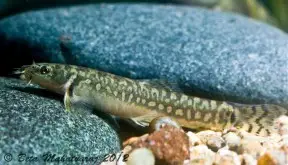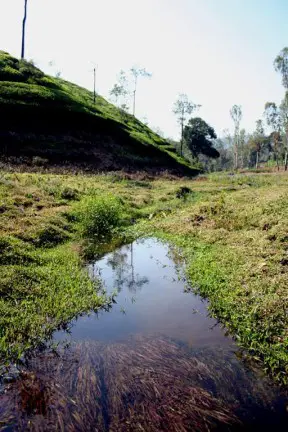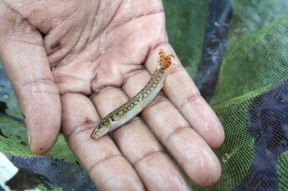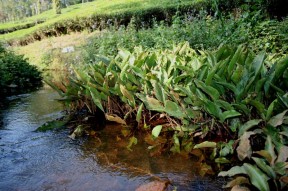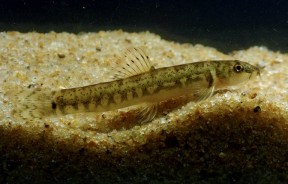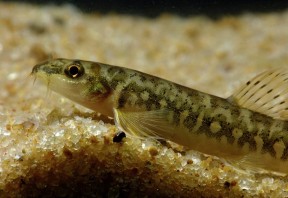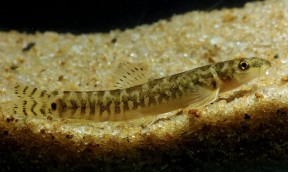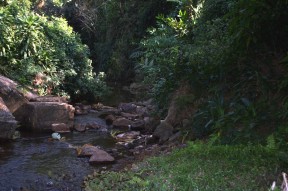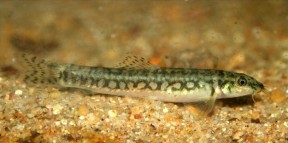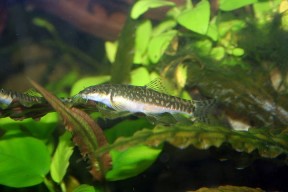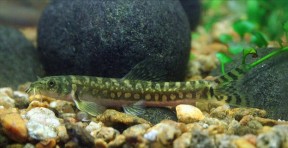Mesonoemacheilus herrei
SynonymsTop ↑
Noemacheilus herrei (Nalbant and Bãnãrescu, 1982)
Etymology
Mesonoemacheilus: from the Greek meso, meaning ‘half’, nema, meaning ‘thread, filament’, and cheilos, meaning ‘lip’, in reference to the relatively less deeply-furrowed lip in members compared to that in Nemacheilus spp.
herrei: named for American ichthyologist Albert William Christian Theodore Herre.
Classification
Order: Cypriniformes Family: Nemacheilidae
Distribution
Described from the Anaimalai Hills range of the Western Ghats mountains in southern India with type locality over 1000 m AMSL in the municipality of Valparai, Coimbatore district, Tamil Nadu state.
The Anaimalai area contains several wildlife sanctuaries and national parks and is home to numerous endangered plant and animal species including ‘flagship’ species such as elephant and tiger.
Habitat
Inhabits clear, well-oxygenated, headwater streams and minor rivers.
These are often shaded by surrounding forest cover with the substrate normally composed of coarse sand, gravel, rocks and boulders covered with an epilithic layer of algae, diatoms plus other microorganisms and detritus.
Aquatic plants are usually absent, though Lagenandra and Blyxa spp. have been observed at some lower-gradient localities.
Flow rate and turbidity vary somewhat depending on the time of year with both increasing dramatically during the annual monsoon season which occurs between June and September.
Maximum Standard Length
50 – 60 mm.
Aquarium SizeTop ↑
An aquarium with a base measuring at least 60 ∗ 30 cm is recommended.
Maintenance
Not difficult to maintain under the correct conditions; we strongly recommend keeping it in a tank designed to resemble a flowing stream or river with a substrate of variably-sized rocks, sand, fine gravel, and some water-worn boulders.
This can be further furnished with driftwood branches arranged to form a network of nooks, crannies, and shaded spots, thus providing broken lines of sight.
While the majority of aquatic plants will fail to thrive in such surroundings hardy types such as Microsorum, Bolbitis, or Anubias spp. can be grown attached to the décor.
Though torrent-like conditions are unnecessary it does best if there is a high proportion of dissolved oxygen and some water movement in the tank meaning power filter(s), additional powerhead(s), or airstone(s) should be employed as necessary.
Like many fishes that naturally inhabit running water it’s intolerant to accumulation of organic pollutants and requires spotless water in order to thrive, meaning weekly water changes of 30-50% tank volume should be considered routine.
Water Conditions
Temperature: 18 – 25.5 °C
pH: 6.0 – 7.5
Hardness: 36 – 215 ppm
Diet
Mesonoemacheilus spp. are omnivorous although the bulk of their diet consists of small insects, worms, crustaceans and other zooplankton with only relatively small amounts of plant matter consumed.
In the aquarium they will accept dried foods of a suitable size but should not be fed these exclusively.
Daily meals of small live and frozen fare such as Daphnia, Artemia, bloodworm, etc. will result in the best colouration and condition.
Behaviour and CompatibilityTop ↑
Fishes which inhabit similar biotopes in nature, especially small, open water-dwelling cyprinids constitute the best options, and one or two schools can make a visible difference to the confidence of this naturally reclusive loach.
Other possibilities include rheophilic loaches from genera such as Pseudogastromyzon, Beaufortia and Sewellia (avoid the more delicate genera, e.g., Gastromyzon) plus benthic cyprinds like Crossocheilus and Garra species.
Similarly-shaped relatives such as other Nemacheilus, Acanthocobitis and Schistura spp. are not really recommended although a combination may work in larger aquaria, while sedate bottom-dwellers such as Corydoras spp. catfishes are best omitted entirely.
This species is relatively peaceful with conspecifics and seems to appreciate being maintained in a group. The purchase of four or more specimens is therefore highly recommended.
Sexual Dimorphism
Adult females are likely to grow slightly larger and be rounder-bellied than males when gravid.
Males have a prominent suborbital flap and develop thickened pectoral-fin rays with rows of tubercules when sexually mature.
Reproduction
Unrecorded in captivity and little has been written about its natural life history, but success with the congener M. triangularis was reported by an American aquarist in 2004.
An adult pair was removed from a community set-up containing several loach species and introduced to a 38 litre tank fitted with a small hang-on filter, the outflow of which was directed towards a plastic box filled with aquarium gravel.
Two large spawning mops were also added and weighed down using a piece of tile, and the author noted that the male was exhibiting reflective reddish-bronze colouration in the lower body and belly.
The male was however found dead the morning so a second individual was introduced since the female still appeared to be gravid.
The following day the fish were observed swimming up and down one side of the tank together, then entering one of the mops.
Close examination using a magnifying glass revealed ‘hundreds’ of clear, non-adhesive eggs on the base of the tank, and the adults were then removed after the male was seen eating them. Water temperature was 76°F/24.4°C.
The eggs were examined under a microscope at various stages of development and recorded to swell to a size of approximately 0.7 mm with a cellular cap apparent at just 3 hours of age.
Hatching seemingly began around 24 hours post-fertilisation, and once complete the mops, tub of gravel and hang-on filter were removed with the latter replaced by an air-driven sponge filter.
Once the first few fry showed signs of eye and intestinal development and had apparently consumed the yolk sac they were fed small amounts of ‘fry starter’, presumably a proprietary product, and by squeezing the sponge from a mature filter into the tank.
Artemia nauplii were introduced to the diet 24 hours later and progressively larger foods as the young fish grew. 500 individuals were eventually raised to saleable size.
NotesTop ↑
It’s unclear if this species has ever been exported for the aquarium hobby outside of India but there may be a chance of finding the occasional specimen mixed in with shipments of M. guentheri or M. triangularis.
It was earlier considered synonymous and may still be confused with M. guentheri since both species share similar body patterning consisting of rows of yellowish, dark-edged spots.
However, according to the identification key of Rema Devi and Indra (2002), the two can be distinguished by a combination of factors as follows: body spots ‘Y’ or ‘V’ shaped (vs. rounded in M. guentheri); caudal peduncle relatively short (vs. relatively long); anal-fin reaching base of caudal-fin (vs. anal-fin not reaching base of caudal-fin); caudal peduncle with a dark spot (vs. caudal peduncle with a dark band or bar); suborbital flap pronounced, being longer than its width (vs. not pronounced and shorter than its width); distance between eye and nostril less than half diameter of eye (vs. more than half); lateral line prominent to origin of anal-fin, discontinuous or absent after (vs. prominent and complete); pelvic-fin extending 75% of distance between its origin and that of the anal-fin (vs. 50%).
With regard to the remaining members of the genus, only M. triangularis is regularly exported for the aquarium trade and is easily told apart since its body patterning consists of 6-7 pale, vertical bars with dark edges and a brownish base colour.
M. petrubanarescui has dark body stripes, M. menoni a reticulated pattern of dark bands and blotches, M. pambarensis more branched dorsal-fin rays (8-10, usually 9, vs. 7-8 in M. guentheri) plus an elongate body, the depth of which fits more than 5.5 times into the SL, M. pulchellus also has more branched dorsal-fin rays (always 10) and M. remadevii lacks dark markings in the fins.
All Mesonoemacheilus spp. are endemic to rivers draining the Western Ghats and the genus is separated from the closely-related Nemacheilus by members possessing two pairs of rostral barbels which are confluent at their bases vs. rostral barbels present but not confluent.
In addition, the lips are usually less deeply-furrowed in Mesonoemacheilus than Nemacheilus spp. while Bãnãrescu and Nalbant (1995) noted that Mesonoemacheilus is the only nemacheilid genus exhibiting a greater degree of brownish than whitish colouration.
Rema Devi and Indra (2002) noted that Schistura savona from northern India uniquely shares both this feature plus possession of confluent rostral barbels and that this may warrant further study, though it appears that this suggestion has not been followed to date.
The family Nemacheilidae is widely-distributed across most of Eurasia with the Indian subcontinent, Southeast Asia and China representing particular centres of species diversity.
References
- Singh, A., N. Sen, P.M. Bãnãrescu and T. T. Nalbant, 1982 - Travaux du Museum d'Histoire Naturelle, vol. 23 (for 1981) : 201-212
New noemacheiline loaches from India (Pisces, Cobitidae). - Boggs, S., 2004 - Finformation 57(7): 4-5
Spawning the Batik Loach (Neomcheilus triangularis). - Bãnãrescu, P. M. and T. T. Nalbant, 1995 - Travaux du Museum d'Histoire Naturelle : 429-495
A generical classification of Nemacheilinae with description of two new genera (Teleostei: Cypriniformes: Cobitidae). - Kottelat, M., 2012 - Raffles Bulletin of Zoology Supplement 26: 1-199
Conspectus cobitidum: an inventory of the loaches of the world (Teleostei: Cypriniformes: Cobitoidei). - Rema Devi, K. and T. J. Indra, 2002 - Journal of the Bombay Natural History Society 99(2): 333-337
A note on Mesonoemacheilus herrei Nalbant and Banarescu (Cypriniformes: Balitoridae: Noemacheilinae). - Shaji, C. P., 2002 - Indian Journal of Fisheries 49(2): 217-221
Mesonoemacheilus remadevii (Pisces: Balitoridae. Nemeacheilinae) from Silent Valley National Park, Kerala. - Tang, Q., H. Liu, R. Mayden and B. Xiong, 2006 - Molecular Phylogenetics and Evolution 39(2): 347-357
Comparison of evolutionary rates in the mitochondrial DNA cytochrome b gene and control region and their implications for phylogeny of the Cobitoidea (Teleostei: Cypriniformes). - Zacharias, V. J. and K. C. Minimol, 1999 - Journal of the Bombay Natural History Society 96(2): 288-290
Noemacheilus menoni, a new species of fish from Malappara, Periyar Tiger Reserve, Kerala. - Šlechtová, V., J. Bohlen and H. H. Tan, 2007 - Molecular Phylogenetics and Evolution 44(3): 1358-1365
Families of Cobitoidea (Teleostei; Cypriniformes) as revealed from nuclear genetic data and the position of the mysterious genera Barbucca, Psilorhynchus, Serpenticobitis and Vaillantella.
